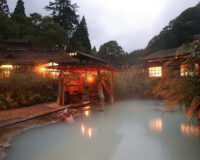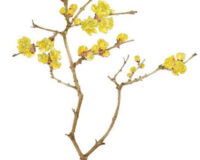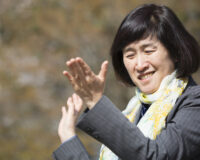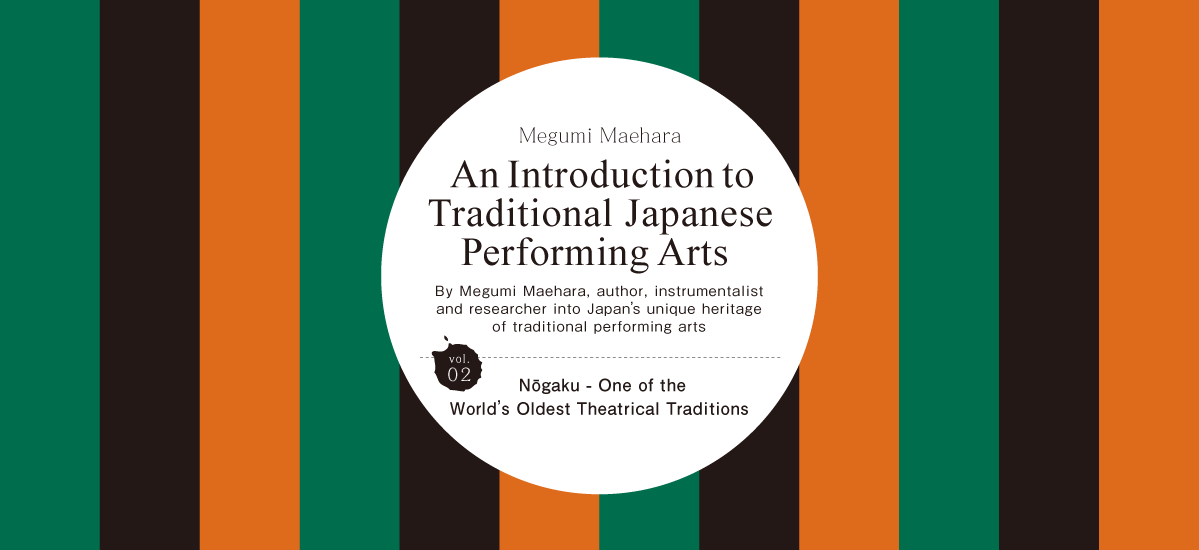

The world of traditional Japanese entertainment – a world that both fascinates and inspires. Explore the history and development of Japan’s traditional performing arts through the ages.
Part 2: Nōgaku – Noh and Kyōgen
Text : 前原恵美 Megumi Maehara / Illustration : Aso Yuriko / English Version : Judy Evans
Keyword : Noh / classical Japanese performing arts / Kyōgen / Nōgaku / Japanese Traditional Performing Arts Series
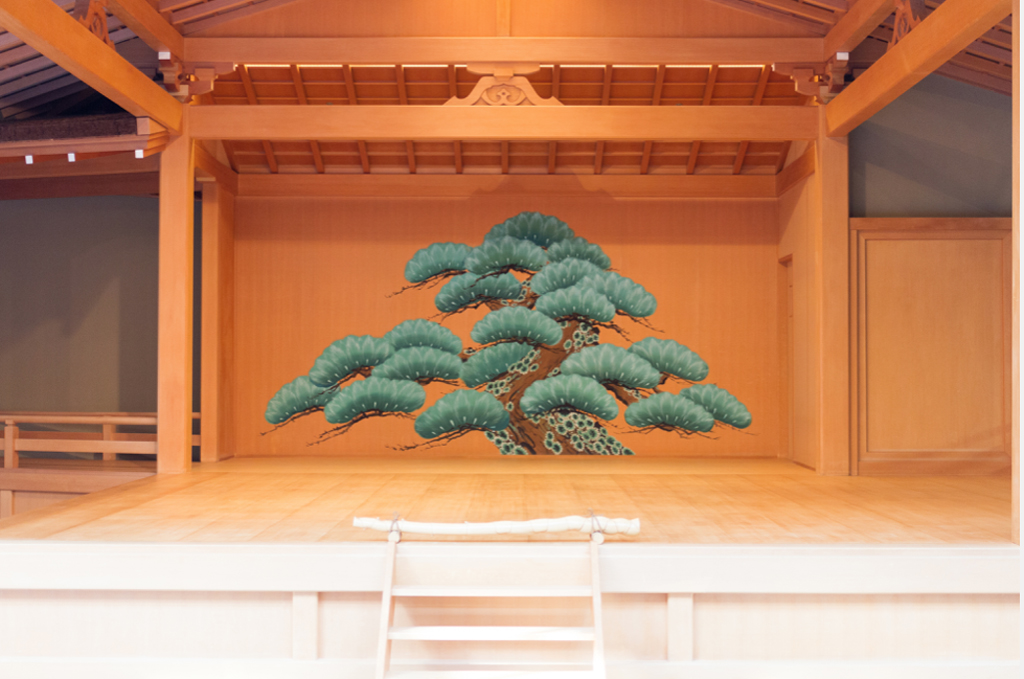
So, what exactly is Nōgaku?
Nōgaku theatre comprises two forms of entertainment that emerged during Japan’s middle-ages: the stately Noh, and the comedic Kyōgen. Noh performances include dance, music and chanting, and take place on a unique, purpose-built stage, originally outdoors. Even although Nōgaku is now generally performed indoors, the entire free-standing stage structure is retained. The proper Nōgaku stage consists of a main stage with columns and a roof, open on three sides and accessed via a bridgeway. There is no curtain separating the audience from the performance space.

The Nōgaku Stage
❶ Hon-butai (main stage). A small square space measuring 5.4 metres each side, open on three sides, with columns and a roof. The stage slopes slightly towards the audience. The narrow area that juts out on the right is called the ji-utai-za. This is where the members of the chorus (ji-utai) sit.
❷ Ato-za (rear seating section). This is where the musical accompanists sit. The four instruments that accompany a Noh performance are nōkan (noh flute), kotsuzumi (shoulder drum), ōtsuzumi (hip drum), both struck with the bare hand, and taiko drum, which is played with bachi (drum sticks).
❸ Kagami-ita (back panel). This is the rear wall of the stage. It traditionally features a painting of an ancient pine tree.
❹ Shite-bashira column. This column is named for the shite (the lead performer).
❺ Metsuke-bashira column. The shite, who performs in a mask that offers limited visibility, uses this column to gauge his position on the stage.
❻ Waki-bashira column. The waki (actor performing the supporting role) takes up his position here.
❼ Fue-bashira column. So named because the fue (flute) player sits next to this column.
❽ Hashi-gakari bridgeway. This is a unique characteristic of the Nōgaku stage. Not only is the hashi-gakari used to enter and exit the main stage, it also functions as a secondary stage that can be used to show a separation in time or space from the events on the main stage. For instance, when the main stage represents the present world, the hashi-gakari can represent the ‘world beyond’; when the main stage is the sea, the hashi-gakari can be land.
The world depicted in Nōgaku.
Nōgaku is an extremely simple form of theatre, comprising stately Noh and comedic Kyōgen. The worlds depicted in Noh come not from everyday life, but from classical literature. Meaning and emotion are hinted at or suggested by stylised movements that are distilled down to their basic essence. This simplicity of expression is the key to world of the imagination, requiring the audience to actively infer the significance of each movement for themselves.
Kyōgen farce on the other hand, focuses on the world of ordinary people. In contrast with Noh, Kyōgen creates comic relief through the use of exaggerated, although highly controlled, movements. Kyōgen also contains elements of irony and satire.
The performers
Nōgaku is performed by both actors and musicians, with the actors specialising in either Noh or Kyōgen.
Noh actors further specialise as either shite-kata (lead or protagonist) or waki-kata (supporting actor). The shite (pronounced ‘sh-teh’) performs/dances in a mask. Shite roles tend to be those of otherworldly beings such ghosts and apparitions, or gods and demons.
The role of waki is sometimes thought of as a subordinate role, but that characterisation is not entirely accurate. The waki is the human counterpart of the shite. The waki is always a character from the real world, sometimes acting as listener for the lead and sometimes confronting the lead character.
In addition to playing the lead role, shite actors may also perform as tsure (companions) alongside the lead, ko-kata (children) and members of the ji-utai (Noh chorus). Another of the shite actor’s responsibilites might be to serve as kōken. This important role is part on-stage costume and props manager, but also stand-in should something go wrong during the performance such as an actor falling off the stage – which is not unknown, due to the restricted visibility afforded by the masks.
Likewise, waki actors might also perform as waki-tsure, or companions to the supporting actor.
Kyōgen actors are known as kyōgen-kata. Far from being just a comic interlude between acts, Kyōgen serves an important purpose. A Noh play is divided into two acts, zenhan and kōhan, with the shite actor withdrawing from the stage to change costumes and masks between acts. Kyōgen serves to link the two acts to each other during this interval by helping to explain the events in the story and even developing the narrative. Kyōgen also provides a lively counter-balance to the more staid Noh performance. Masks are not generally used in Kyōgen, other than to depict non-human characters such as gods or animals.
The hayashi-kata (musician roles) are named according to the instrument each musician plays: fue-kata (flute), kotsuzumi-kata (shoulder drum), ōtsuzumi-kata ( hip drum) and taiko-kata (taikodrum).
This specialisation of roles and the hours of rigorous training in Noh enable the performers to hone their craft to an extremely high degree.
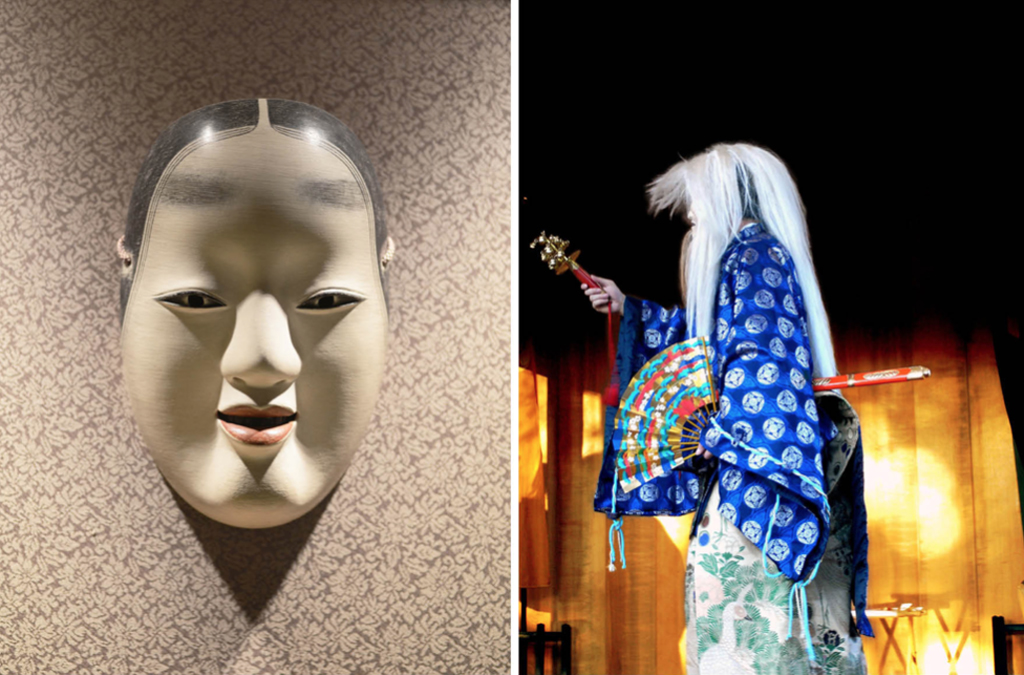
The origins of Nōgaku
Noh and kyōgen are derived from sangaku, which was introduced to Japan from T’ang Dynasty China during the Heian Period (794 – 1185). In its original form, sangaku was a wide-ranging form of entertainment similar to a circus, comprising singing, dancing, mime, slapstick and acrobatics. This popular entertainment, which came to be called sarugaku, was adapted and refined, focussing on the aspects of the entertainment most suited to Japanese tastes. It assimilated other forms of traditional entertainment, such as fūryū (a kind of dance procession accompanied by flute and cymbals) and kuse-mai (a dance performed by one or two people, accompanied by hand-drums and chanting), and became associated with religious festivals as a uniquely Japanese form of theatre.
Sarugaku entertainers formed troupes, or ‘za’, with each troupe intent on refining their techniques and developing their own original representations of sarugaku. Two stars who emerged from these troupes were Kan’ami and his son, Zeami. They found favour with the young shōgun, Ashikaga Yoshimitsu, and moved to the capital, Kyōto, where they performed at the court under his patronage. Kan’ami and Zeami transformed the somewhat raucous sarugaku into a refined and elegant form of theatre with an emphasis on musicality. This was the point at which Noh parted ways with sarugaku.
On the other hand, sarugaku, a playful form of entertainment that delighted in satirising those of high rank, gained popularity among commoners and became the basis of kyōgen.
Although Noh and Kyōgen developed along separate paths, they continue to be performed on the same stage, with Kyōgen performances inserted between Noh performances, each highlighting the uniqueness of the other.



